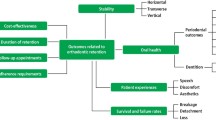Abstract
Data sources The Cochrane Oral Health Group's Trials Register, The Cochrane Central Register of Controlled Trials (CENTRAL), Medline and Embase were searched. Several journals were searched by hand (American Journal of Orthodontics and Dentofacial Orthopedics (formerly American Journal of Orthodontics), Angle Orthodontist European Journal of Orthodontics, Journal of Orthodontics (formerly British Journal of Orthodontics)). No language restrictions were applied. Authors of published reports of randomised controlled trials (RCT) were identified and contacted to identify further unpublished trials. The most recent search made was in December 2002.
Study selection Only RCT were chosen for inclusion. Studies included children and adults who had retainers fitted or adjunctive procedures undertaken after orthodontic treatment with braces to prevent relapse. The outcomes were how well the teeth were stabilised, survival of retainers, adverse effects on oral health and quality of life.
Data extraction and synthesis Screening of eligible studies, assessment of methodological quality of the trials and data extraction were conducted in duplicate and independently by two reviewers. Because no two studies compared the same retention strategies (interventions), it was not possible to combine the results of any studies.
Results Four trials satisfied the inclusion criteria. These trials all compared different interventions: circumferential supracrestal fiberotomy (CSF) combined with full-time removable retainer versus a full-time removable retainer alone; CSF combined with a nights-only removable retainer versus a nights-only removable retainer alone; removable Hawley retainer versus a clear overlay retainer and three types of fixed retainers versus a removable retainer. There was weak unreliable evidence, based on data from one trial, that there was a statistically significant increase in stability in both the mandibular (P<0.001) and maxillary anterior segments (P<0.001) when the CSF was used, compared with when it was not used. There was also weak, unreliable evidence that teeth settle quicker with a Hawley retainer than a clear overlay retainer, after 3 months. The quality of the trial reports was generally poor.
Conclusions There are insufficient research data on which to base our clinical practice on retention at present. There is an urgent need for high-quality RCT in this crucial area of orthodontic practice.
Similar content being viewed by others
Commentary
This article reports the present evidence available in the literature regarding the effectiveness of different retention strategies that are used in clinical practice to stabilise the position of teeth following orthodontic treatment. This phase of orthodontic treatment is as important because the actual tooth movement as the goal of treatment encompasses not only moving the teeth but also maintaining them in the most stable position following treatment.
The background and objectives of this paper are very clearly set out. The inclusion criteria were strict to ensure assessment of stability after comprehensive orthodontic treatment and excluded partial treatment and space-maintenance interceptive treatment. RCT with similar populations that had complete treatment were the goal of the search.
The search strategy was comprehensive, looking electronically and by hand, in reference lists and via personal communication. Including the search word “relapse”, however, might have identified other papers that assessed relapse but also included the type of retention used. Studies that assess relapse are closely related to those that assess stability and often look at similar aspects of treatment even though they approach the problem from different ends of the spectrum.
The authors review the literature well and validly conclude that there is not sufficient information available in the literature to support or invalidate our methods in clinical practice. This work would be even more valuable if the reader was provided with a critique of the literature that is available, in order to either better assess future studies or to better design studies of their own. An expanded discussion that commented upon future assessments would be helpful. Items that might be commented upon include those listed below.
-
The methods used here to assess stability were not comprehensive. Little's index of irregularity1 does not assess the stability of all aspects of the occlusion such as the posterior lateral or antero-posterior relationships. Similarly, the amount of settling based on occlusal contacts does not provide specific information about stability. The occlusal contacts may have increased but there could be lateral relapse with crossbites returning as well as another three-dimensional relapse that is not accounted for when simply evaluating occlusal contacts. The methods used to assess stability should evaluate all aspects of the occlusion and any three-dimensional changes.
-
It would be of more value to the clinician to know the stability of certain malocclusions in relationship to the type of retention, ie, there may be advantages to using a specific type of retainer with rotations or a Class II division II malocclusion.
-
The specific type of removable appliance should be identified, as there are many types that could provide varying degrees of stability to the finished occlusion.
-
The occlusal stability needs to be assessed for longer than 3 months and at least up to 1 year, if not 2 year(s), post-orthodontic treatment.
References
Little RM, Wallen TR, Riedel RA . Stability and relapse of mandibular alignment — first four premolar extraction cases treated by traditional edgewise orthodontics. Am J Orthod Dentofac Orthop 1981; 80:349–365.
Author information
Authors and Affiliations
Additional information
Address for correspondence: Emma Tavender, Review Group Co-ordinator, Cochrane Oral Health Group, MANDEC, Higher Cambridge Street, Manchester M15 6FH, UK. E-mail: Emma.Tavender@man.ac.uk
Littlewood SJ, Millett DT, Doubleday B, Bearn DR, Worthington HV. Retention procedures for stabilising tooth position after treatment with orthodontic braces (Cochrane Review). In The Cochrane Library. Chichester: John Wiley; 2004, Issue 1
Rights and permissions
About this article
Cite this article
Russell, K. What type of orthodontic retainer is best?. Evid Based Dent 5, 106 (2004). https://doi.org/10.1038/sj.ebd.6400286
Published:
Issue Date:
DOI: https://doi.org/10.1038/sj.ebd.6400286
This article is cited by
-
Changes in the distribution of occlusal forces in the course of the orthodontic retention phase
Journal of Orofacial Orthopedics / Fortschritte der Kieferorthopädie (2023)



